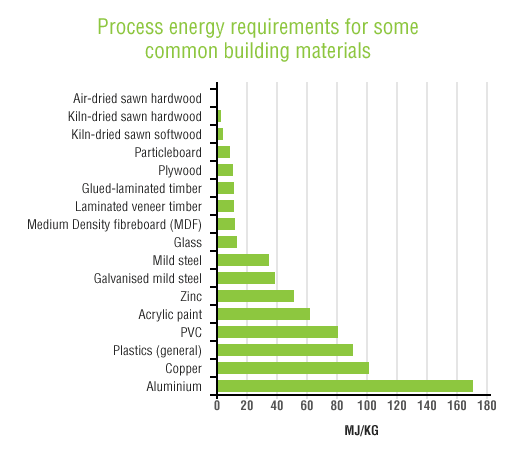Timber – A Good Choice for the Environment
Forests and wood products can effectively reduce the process of climate change in several ways.
Growing trees absorb carbon dioxide from the atmosphere and store the carbon so efficiently that about half the dry weight of a tree is carbon. This carbon remains locked up in the wood even when we use it for building products or furniture.
Using wood instead of other materials can be an advantage too. The production of wood products uses less energy (usually sourced from finite fossil fuels) compared with some other building materials.
As a fuel, sustainably grown and harvested wood (and other biomass) provides a renewable alternative to fossil fuels.
Embodied Energy
From governments to owners, designers and occupiers, there is an increased focus on improving the sustainability of our built environment. When compared with other building materials, wood products can play a positive role in reducing greenhouse gas emissions.
When choosing building materials, it’s important to consider the amount of energy (often derived from finite fossil fuels) used in the manufacturing process. Compared with some other building materials, the production of wood often requires less energy in the harvest, transportation and manufacturing processes – this is called embodied energy. Substituting wood for another material can be an easy and economical way to reduce a structure’s carbon footprint.
It is estimated that, in Europe, a 10% increase in the percentage of wooden houses constructed would produce sufficient CO2 savings to account for about 25% of the reductions prescribed for Europe by the Kyoto Protocol.
Hardwood and Embodied Energy
Industrial processing of all natural resources into forms useable by people requires energy, most often in the form of fossil fuels. In burning fossil fuels to release energy, carbon is also released into the atmosphere. A measure of the amount of energy used to prepare, for example, building materials from iron ore, bauxite or forests, is embodied energy. Embodied energy is a useful way to compare the environmental friendliness of building materials.
Compared with other common building materials such as steel, aluminium and concrete, hardwood timber not only stores carbon, it uses up to 85-times less energy in processing.
In simple terms, a concrete slab floor uses 60% more energy than a timber floor, double brick walls use almost 5-times more energy than weatherboards on timber framing, and an aluminium window uses 45% more energy than an equivalent timber window.
The substitution of timber elements for more energy expensive products in the building process results in a worthwhile energy saving. Even highly processed timber products, such as glue laminated timber, store more carbon within their structure than is released by their manufacture.
Buildings are seldom constructed of a single material, so the embodied energy of a structure depends on the mix of materials used. Research continues to refine the measurement of embodied energy of buildings. One analysis suggests that construction of a brick-veneer house with timber framing gives savings of about 8.8 tonnes of CO2 per house compared with double brick construction (Attiwill et al 2001).
A sustainably managed resource
Australia’s forest management is among the best in the world in terms of conservation reserves and codes of practice for production forests. Only 6% of Australia’s 147 million hectares of native forests is public forest potentially available for timber harvesting. Timber is harvested from about 1% of these public native forests each year.

